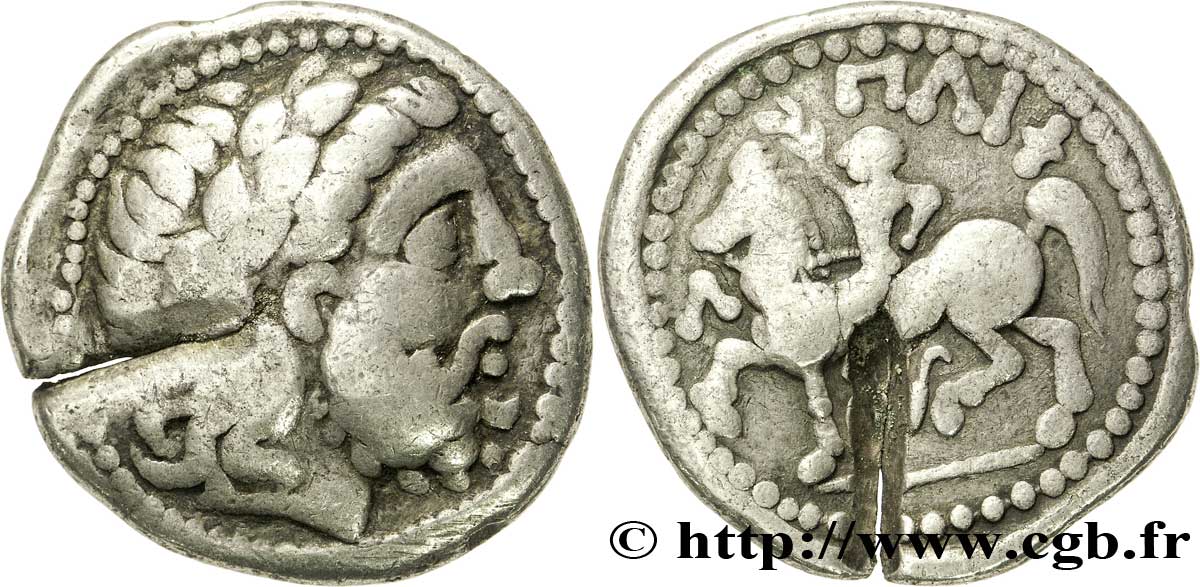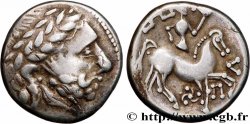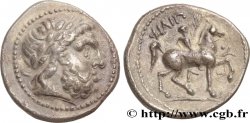v53_0681 - CELTI DEL DANUVIO Tétradrachme au cavalier, imitation de Philippe II
MONNAIES 53 (2012)
Начальная цена : 190.00 €
Назначить цену : 300.00 €
непроданный лот
Начальная цена : 190.00 €
Назначить цену : 300.00 €
непроданный лот
Тип Tétradrachme au cavalier, imitation de Philippe II
Дата: (IIe-Ier siècles avant J.-C.)
Металл: silver
Диаметр: 26,5 mm
Ориентация осей монеты: 10 h.
Вес: 13,52 g.
Редкость: R2
Комментарии о состоянии
Monnaie complète et frappée sur un flan large. Les reliefs sont émoussés par une usure assez marquée. Le flan est coupé d'un important coup de burin. Sinon, patine grise de collection ancienne
Ссылки в каталоге: :
Лицевая сторона
Аверс: легенда: ANÉPIGRAPHE.
Аверс: описание: Tête laurée de Zeus à droite ; grènetis.
Обратная сторона
Реверс: Описание: Cavalier au pas à gauche, tenant une palme de la main droite ; le cheval lève l'antérieur à droite ; entre les jambes du cheval, I et E.
Реверс: легенда: FILP - L
Комментарий
Si le statère d’or de Philippe II de Macédoine a servi de prototype à de nombreuses imitations gauloises, le tétradrachme n’a pas été imité en Gaule, mais reste principal sujet d’inspiration des monnaies pour les Celtes du Danube (LT. 9697-9767, 9768-9832, 9618-9630, 9870-9886). Les premières imitations furent frappées dans le premier quart du IIIe siècle avant J.-C. La fabrication des copies serviles, puis des imitations, enfin des frappes celtiques continuèrent pendant plus de deux siècles.
Le revers avec le cheval à gauche semble moins courant dans les imitations de Philippe II que ceux avec le cheval à droite. Sur cet exemplaire, la légende est rétrograde et erronée, avec FILP - L.
While the gold stater of Philip II of Macedon served as a prototype for many Gallic imitations, the tetradrachm was not imitated in Gaul, but remains the main source of inspiration for coins for the Danube Celts (LT. 9697-9767, 9768-9832, 9618-9630, 9870-9886). The first imitations were struck in the first quarter of the 3rd century BC. The manufacture of servile copies, then imitations, and finally Celtic strikes continued for more than two centuries. The reverse with the horse on the left seems less common in imitations of Philip II than those with the horse on the right. On this example, the legend is retrograde and erroneous, with FILP - L
Le revers avec le cheval à gauche semble moins courant dans les imitations de Philippe II que ceux avec le cheval à droite. Sur cet exemplaire, la légende est rétrograde et erronée, avec FILP - L.
While the gold stater of Philip II of Macedon served as a prototype for many Gallic imitations, the tetradrachm was not imitated in Gaul, but remains the main source of inspiration for coins for the Danube Celts (LT. 9697-9767, 9768-9832, 9618-9630, 9870-9886). The first imitations were struck in the first quarter of the 3rd century BC. The manufacture of servile copies, then imitations, and finally Celtic strikes continued for more than two centuries. The reverse with the horse on the left seems less common in imitations of Philip II than those with the horse on the right. On this example, the legend is retrograde and erroneous, with FILP - L








 Cообщить об ошибке
Cообщить об ошибке Распечатать страницу
Распечатать страницу Отправить мой выбор
Отправить мой выбор Задать вопрос
Задать вопрос Consign / sell
Consign / sell
 Информация
Информация











